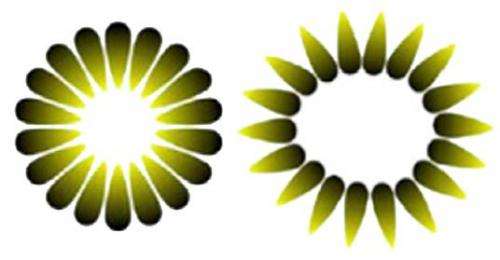Image (c) PNAS, doi:10.1073/pnas.1118298109
(Medical Xpress) -- We all know that our pupils contract when our eyes are exposed to increases in the brightness of light. The reason is to both protect the delicate inner workings of our eyes and to help provide for optimum viewing based on available light. But we also know that our pupils dilate, or become larger when we are aroused, regardless of the reason, which means that pupil size is not always just a reaction to lighting conditions. Now, new research by Bruno Laeng and Tor Endestad from the Department of Psychology at the University of Oslo, shows that our pupils also react based on what we think we see sometimes, rather than what is actually there. In their paper, published in the Proceedings of the National Academy of Sciences, the two show that pupil constriction occurs when viewing an optical illusion that at first makes us believe one image is brighter than another, when in reality, they are the same.
The pupil is a hole in the front of the eyeball and is the means by which light enters its inner workings, allowing us to see. The size of the pupil is adjusted by tiny muscles in the iris, working as a sphincter, causing either contraction or dilation, effectively decreasing or increasing its diameter, which allows either less or more light to pass through to the lens and eventually the retina. The pupil changes size autonomously and like organs such as the heart, responds based on stimuli and environmental conditions.
In this new experiment, the researchers showed volunteers cards with two images on them. Both reflected the same amount of light, but because of the way they were created, appeared to be different, i.e. one seemed to reflect back more light, causing it to look brighter than the other. As the volunteers were looking at the two images, the researchers measured minute changes in the size of the pupil. In so doing, they found that the pupil constricted slightly more when the focus was on the image that appeared brighter. This the team suggests, means that some part of our brain is processing information from our eyes and is causing our pupils to contract based on what it thinks it sees, rather than what is actually there, which means our brains are trying to anticipate what it thinks is happening, or is going to happen and instructs the pupil to respond accordingly.
They also found that if the volunteers were allowed to look at the image for a longer length of time, the brain finally figured out that the light wasn’t any greater and opened the pupils once again to the same degree as was observed when focusing on the other less bright looking image.
More information: Bright illusions reduce the eye's pupil, PNAS, Published online before print January 23, 2012, doi: 10.1073/pnas.1118298109
Abstract
We recorded by use of an infrared eye-tracker the pupil diameters of participants while they observed visual illusions of lightness or brightness. Four original illusions {based on Gaetano Kanisza's [Kanizsa G (1976) Subjective contours. Sci Am 234:48–52] and Akiyoshi Kitaoka's [Kitaoka A. (2005) Trick Eyes (Barnes & Noble, New Providence, NJ).] examples} were manipulated to obtain control conditions in which the perceived illusory luminance was either eliminated or reduced. All stimuli were equiluminant so that constrictions in pupillary size could not be ascribed to changes in light energy. We found that the pupillary diameter rapidly varied according to perceived brightness and lightness strength. Differences in local contrast information could be ruled out as an explanation because, in a second experiment, the observers maintained eye fixation in the center of the display; thus, differential stimulation of the fovea by local contrast changes could not be responsible for the pupillary differences. Hence, the most parsimonious explanation for the present findings is that pupillary responses to ambient light reflect the perceived brightness or lightness of the scene and not simply the amount of physical light energy entering the eye. Thus, the pupillary physiological response reflects the subjective perception of light and supports the idea that the brain's visual circuitry is shaped by visual experience with images and their possible sources.
Journal information: Proceedings of the National Academy of Sciences
© 2011 PhysOrg.com




















